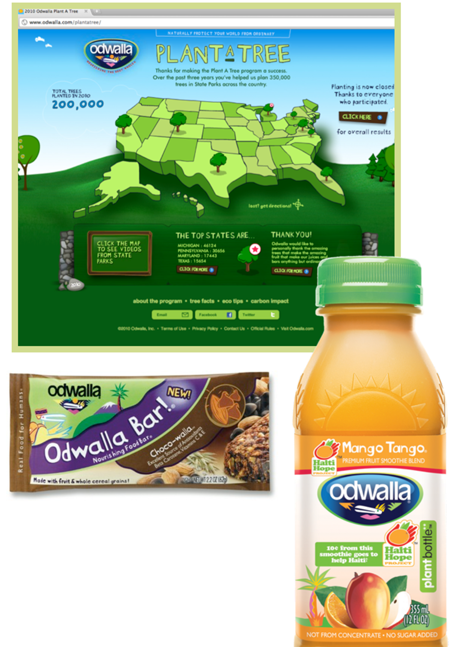 Do you have your strategy and audience defined and in place, but are not sure how to measure success?
Do you have your strategy and audience defined and in place, but are not sure how to measure success?
The appropriate measuring tools will depend on the objectives you’ve set, as with any marketing plan, but in cause marketing there are a few key things that should always be measured:
Reach
During the initial stages of your campaign, the reach metric will determine how many people within your audience were exposed to your new messaging. Increasing awareness among your target audience is the very first step in initiating a deep connection. Work with your marketing agency to determine which types of reach will prove the most effective for your specific brand and campaign.

Odwalla Campaign by Good Solutions Group
Engagement
If the reach portion of your campaign proves successful, it can facilitate the audience behavior flow from awareness to engagement. This is especially important in cause marketing because interaction and a positive voluntary response from your audience are good indicators of their attitude and willingness engage with your brand.
Example: The Odwalla Plant a Tree campaign drove 35% of all website visits and Facebook fans for the brand during promotion, demonstrating that audiences took initiative to learn more about the brand’s activities.
Earned Media
Business initiatives that are relevant to your audience and are positively impacting communities often drive significant earned media, driving broader reach. Apart from saving you advertising dollars, having a third party such as community papers, bloggers and news networks brings credibility to what you’re doing. This campaign for Coca Cola earned over 600 million impressions worth $2.5 MM, but also, it demonstrated that those that chose to write about the campaign decided it was valuable news for their readers.
Brand Sentiment
Think back to the reason your organization decided to develop a cause marketing campaign. What were some of the attitudes toward your brand that needed to be addressed? Was one of your goals to create a stronger emotional bond with your audience? Were you hoping to increase brand loyalty? Determine your starting point, the audience attitudes and compare it to where you are now to evaluate if your cause marketing is influencing brand sentiment.
Business Goals
Cause marketing done right will support your business goals, and these should be monitored closely during the timeframe of your campaign to evaluate the success of your efforts. Good Solutions Group monitored Dasani’s retail sales throughout the time of the campaign created to communicate Dasani’s evolution into a plant-based bottle, which helped reverse purchase decline at retail from -15% to +76% average, with a high of +239%.
A recent survey by Kelley Blue Book reveals that corporate social responsibility can lead to sales increases for the automotive industry as “Sixty-two percent say they are more likely to purchase a vehicle brand if that brand is promoting a social good campaign.”
Subaru was mentioned as a leading automotive brand with campaigns that maintained long term impressions: “For those who have heard of specific social good campaigns, Subaru had the highest percentage of recollection at 61%”
Our campaign for Subaru aimed to create awareness of the new Subaru Outback model in 2010, and a cause marketing partnership with parks allowed for active lifestyle audiences and park lovers to test the cars at in-park events. By measuring test drives and impressions, engagement and awareness were evaluated to be successful.
Increased Sales is another business oriented measurable outcome to be monitored after your cause marketing campaign. According to the Cone Communications Social Impact Study, millennials are 89% more likely to buy products and services from companies with a CSR initiative. To get any idea of how much effect a cause marketing campaign can have on sales, keep in mind that Good Solutions Group campaigns average a 201% ROI.
A combination of all these metrics and others as needed to evaluate your specific campaign can help keep your efforts on track and evaluate whether your audience is having the response to the campaign messaging that you hoped for.

